Near East #3
1/26
There's no tags or description
Looks like no tags are added yet.
Name | Mastery | Learn | Test | Matching | Spaced |
|---|
No study sessions yet.
27 Terms
Assyrian Art (Neo-Assyrian Empire)
900-612 BC
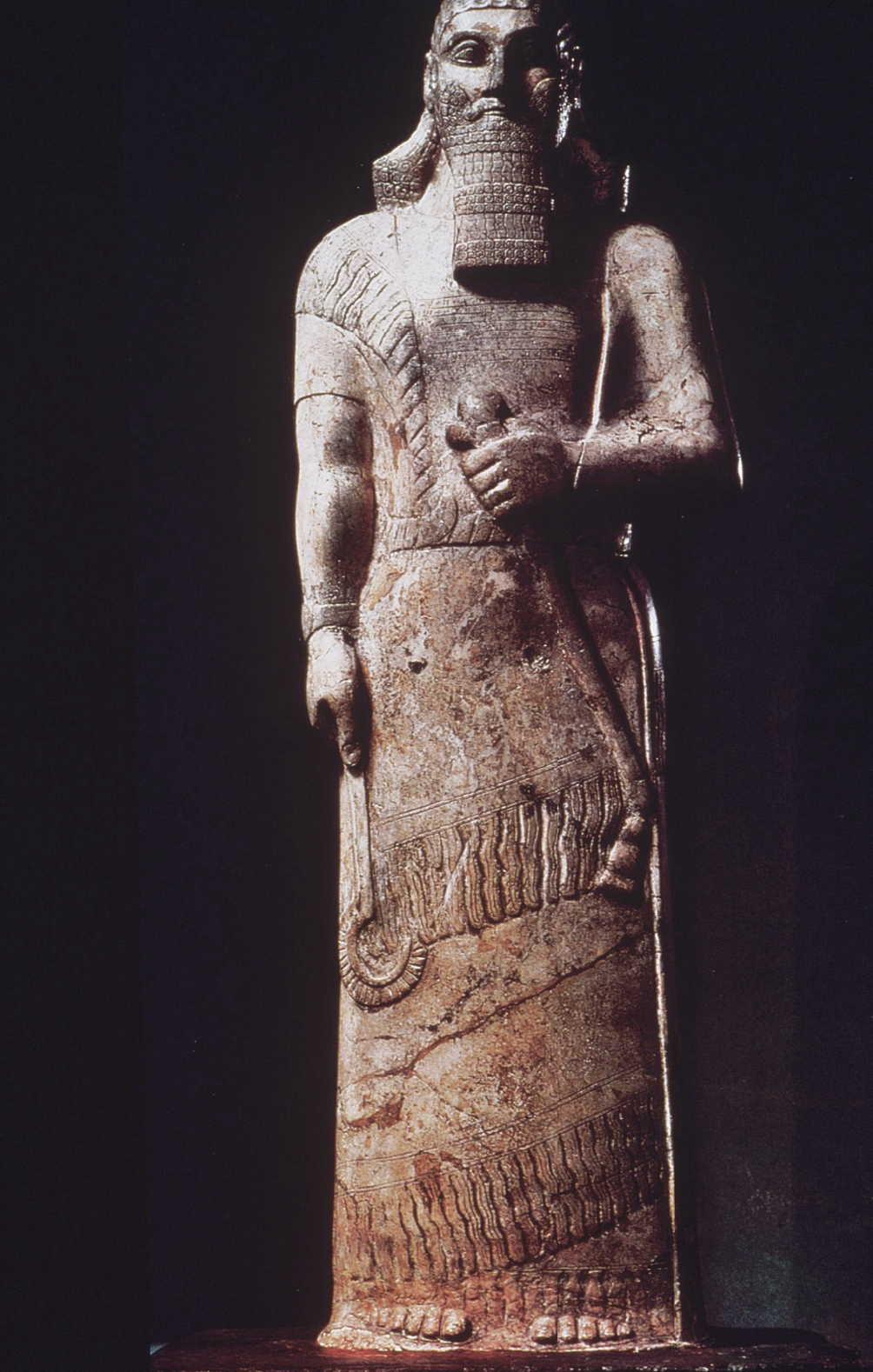
title, date, material, findspot
Statue of Assurnasirpal II
Neo-Assyrian Period, 883-859 BC
Magnesite on red dolomite plinth
Temple of Ishtar, Nimrud
3 feet, 5.25 in high
Statue of Assurnasirpal II
Built a new capital at Nimrud
Over 3 feet tall and would stand on a base that was 2 feet tall
Familiar:
Shape (cylinder shape) → Mesopotamian form
Pius king (Gudea king)
One armed robe (fancy robe on)
On top of robe, there is a fringe shawl that is wrapped around his body
Tucked in his belt
Holding things that show power → cykel (Type of weapon the gods would have used to fight off monster)
Not related to justice like to rod and ring
Huge, long, ornate beard
Longer hair → curves outwards
Big inscription carved on his chest
Situation where writing is mixed into art
They used stone: gypsum/limestone
Readily available
Style:
Cylinder shape
Muscular (round/stocky figure)
New: fringe and you could see his thumbnails
Has a ton of detail
Toenails on feet, strands of hair
How does the artist show the details?:
Subtractive (subtracting the stone)
Modeling (as if you are using clay – smooth stone)
Details are not shown through modeling
Not sculpting individual strands
Take a tool and insize it into a stone (in-sizing)
Function:
Found in a temple of Ishtar
Perpetual reminder of the deity – king’s devotion
Way to connect kings to deities
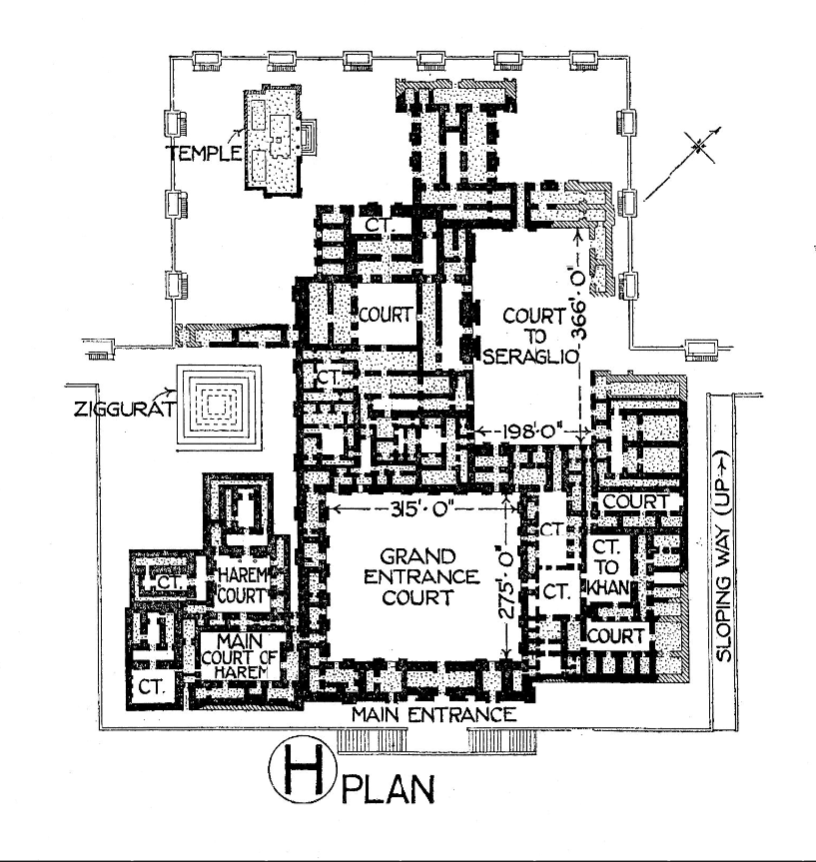
title, date, material, findspot
Plan of the Palace Citadel of Khorsabad
Neo-Assyrian Period, 883-859 BC
Khorsabad (ancient Dur Sharrukin), Iraq
Plan of the Palace Citadel of Khorsabad
Palaces are not preserved very well
721-705 BC reigned, city named after king
King was killed in a battle
King died before it was finished
City was deserted
Role of Assyrian city:
City was meant to present the Assyrian Empire to the civilized world
Meant to be a statement
Wanted to show power and glorify reigns
Covers one square mile
Pretty symmetrical
City gates
And palace
Fortress area that protects the southern wall
‘F’ might be a tiny palace → right near a gate (Gate 5)
Gate 5 was important → traffic
Enter through gateway
Center square that was called “square of the foreign peoples”
In the heart of the city
Place where people gathered for important occasions
Military expeditions set out from there
Has its own Ziggurat
Palace itself is interesting
Set up on platform
Entered the palace through a tripled entrance that brought you too an enormous court
Administrative offices and religious areas (temples)
Private apartments for the King
Great throne great (VII) with huge court outside of it (VIII)
Basic architecture:
Series of squares and rectangles
Public spaces, religious spaces, administrative spaces, and apartments
What was it made out of?:
Palaces are built out of mudbrick (sun dried mudbrick)
Mudbrick would sometimes be glazed with colors
Sometimes the interior of the rooms would have painted walls
Other walls had carved panels with stone
Along walls → thin, huge slabs of gypsum that would be carved/inscribed with scenes
“Don’t cross Assyrian ruler…”
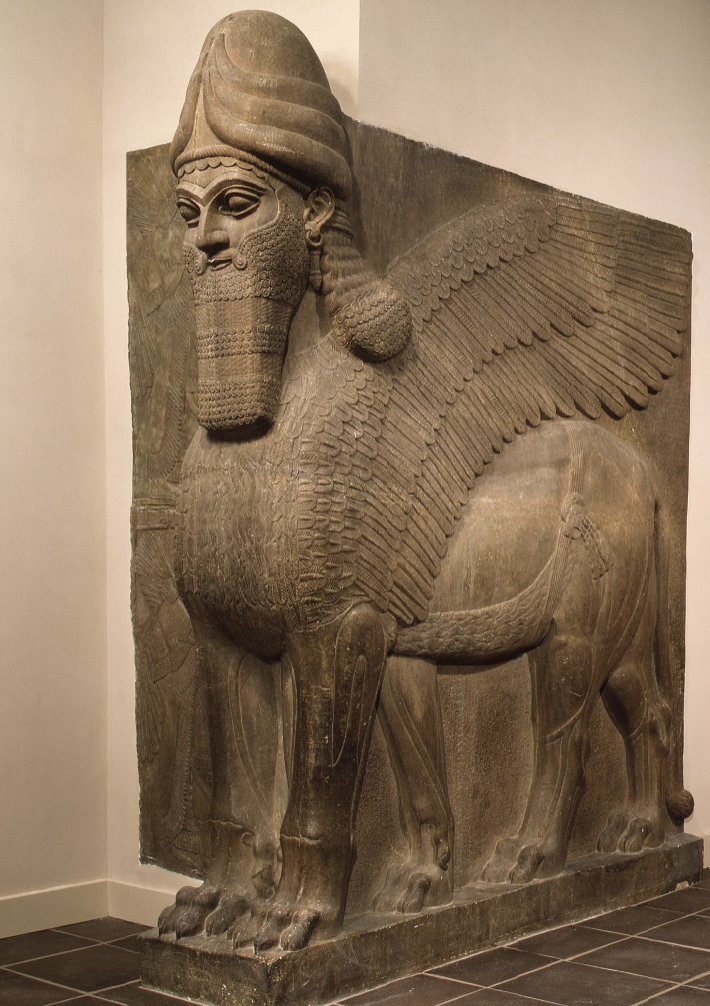
title, date, material, findspot
Winged Bull — Lamassu
Neo-Assyrian Period, 883-859 BC
Gypsum Alabaster
Nimrud, Iraq
Winged Bull — Lamassu
Greet visitors
Mixed mythological creature
Enormous
Can be up to 5 meters tall
Can be carved from a single block of stone
Example of Assyrian guardian figure
Lots of deity iconography
Lamassu – guardian figure that the Assyrians marshalled to guard their palaces
Bodies to bulls, but have human heads and have wings
Installed at various gateways and entrances to palaces
Message of power and connection between the divine forces (and protection from the divine forces)
Mostly put at doorways
Ward off the entrance of evil spirits
Have plenty of deity iconography
Horned cap (multi-layered)
Stylized beard and stylized long hair (what kings wear)
Mixtures of humans and animals
Assyrian reliefs made out of local stone known as Gypsum
Hyper attention to detail
Details shown through carving through the block of stone → incision
Multiple feet → all about perspective
Fitted in a way through locations
Corner of entrance
Less cylindrical than we are used to
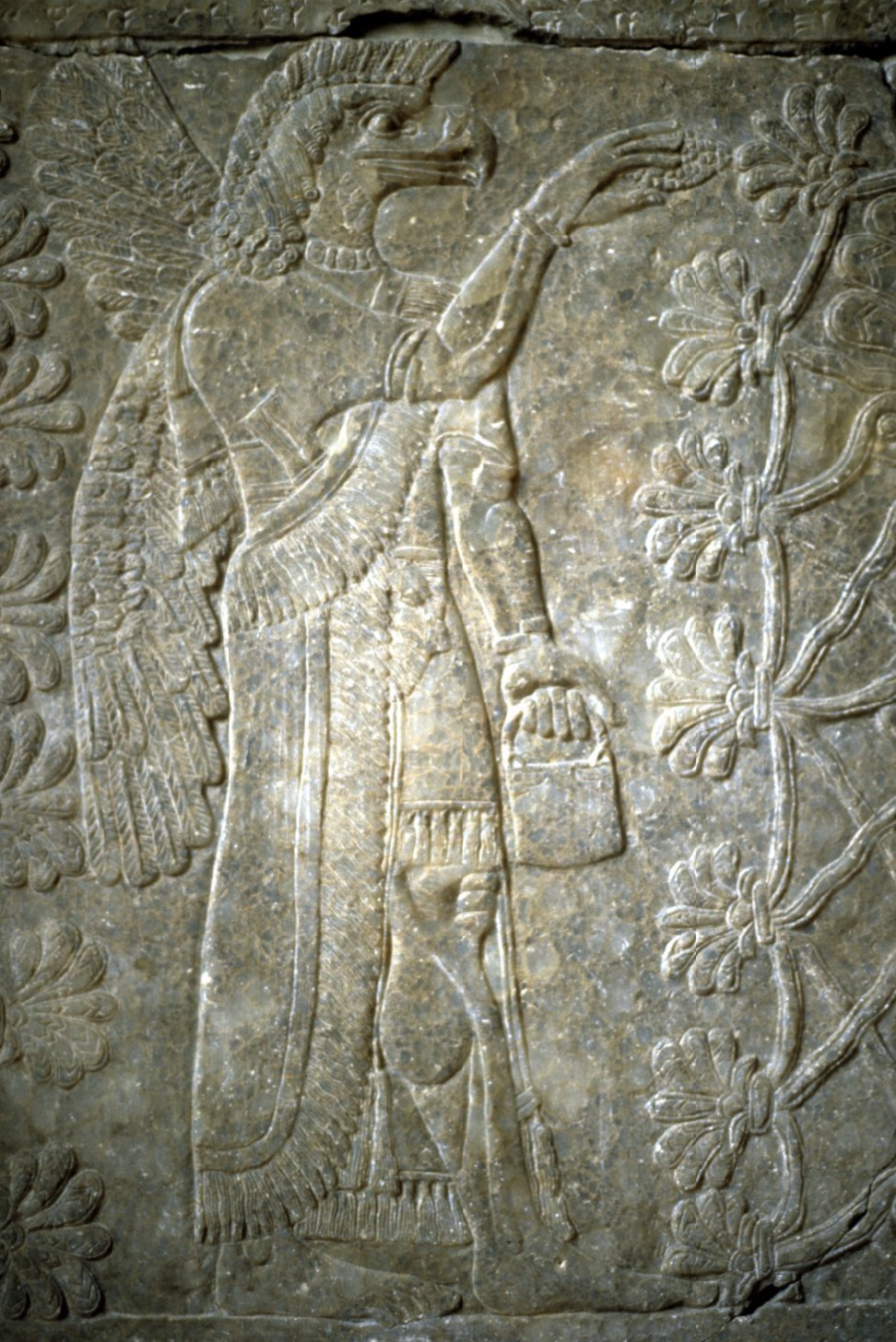
title, date, material, findspot
Kneeling Genies and Sacred Tree
Neo-Assyrian Period, 883-859 BC
Gypsum alabaster
Nimrud, Iraq
Kneeling Genies and Sacred Tree
Meant to be seen by visitors
Send propaganda messages
Celebrate king’s conquest
Demonstrate king’s power by killing lions
Majority of reliefs are carved out of gypsum/alabaster
Grayish white in color
Interesting property → hardens and darkens when exposed to air
Plenty of it → available
Quarry stone with iron picks
Cut into rough blocks to make sure it is the proper dimensions
Slice slabs off of blocks
Mount slabs onto the palace walls
Then carve them
Polish them and then painted
Displayed in public areas or private areas → can tell by what scene is being shown
Low relief
Hyper attention to detail
Early reliefs → scenes that stuck together on one stone (compressed)
Symbols of deities → not a lot of scenes
Whole story happens in one scene
By end of Assyrian Period → dimensions of the stone/slab were ignored
Little minor scenes
Artistic conventions
Used hieratic scale → ruler is always larger
Comic book representation (narration)
A series/two scenes of winged genies (top) and eagle-headed genies (below)
Guardian figures
Holding buckets and pinecones
Sacred tree
Gives the viewer a window into Assyrian ritual and religion
In between scenes → cuneiform inscription
Located in throne room, right behind the throne
Seated king was apart of the scene that was occurring
Became part of complex/ritual activity
Attention!
See toenails
Little bits of wing (pieces of feathers)
See fringe from wig
Decorated with earrings, necklaces, and bracelets
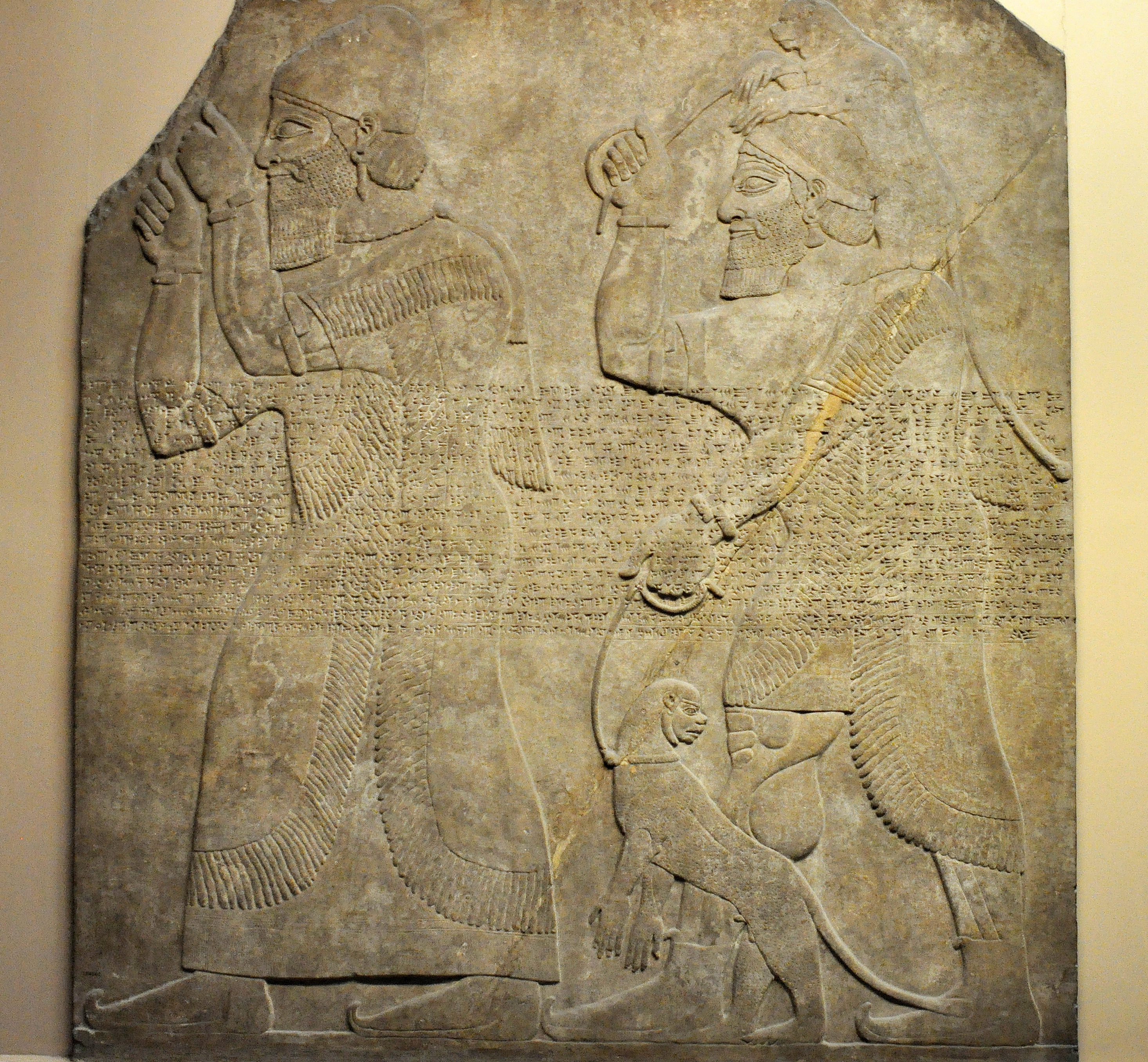
title, date, material, findspot
Tribute Bearer Procession
Court D, Northwest Palace
Neo-Assyrian Period, 865 BC
Gypsum alabaster
Nimrud, Iraq
Tribute Bearer Procession
Trained monkey → bringing tribute to king
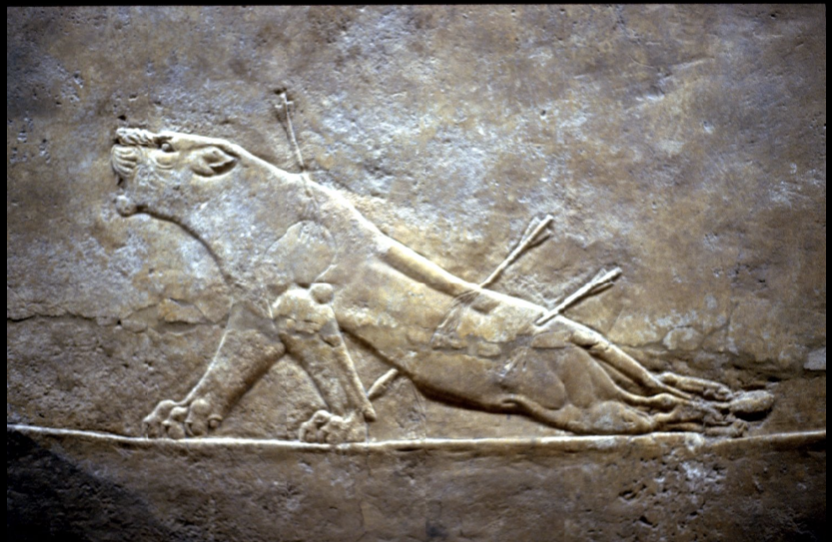
title, date, material, findspot
Lion Hunt (Ashurbanipal)
Neo-Assyrian Period, 645-625 BC
Gypsum alabaster
North Palace, Nineveh, Iraq
Lion Hunt (Ashurbanipal)
Lion hunts were popular during time
Hunt was not real
Series shows King’s zoological park
Lion hunts were staged for the king’s participation
Did not hunt lions off of horse back → still used chariots
Chariots needed drivers
Chariots and lion huntings are a symbol of control
Assyrian King (sending message of powerful king):
Focal point
Horizontal movement of chariot, but king is vertical
Diagonal from torso of lion and is picked up by diagonal of king’s arm
Axis of motion
King has already killed a lion → can see arrows
Faces of people are very static (dead-pan)
Lion’s faces are open, powerful, violent roar
Scale of lion and scale of king
Curve of arrow is parallel to the curve of the wheel
Dead space in between → shows off king
Composition is carefully thought out
Lion is message to the visitors to not cross the king
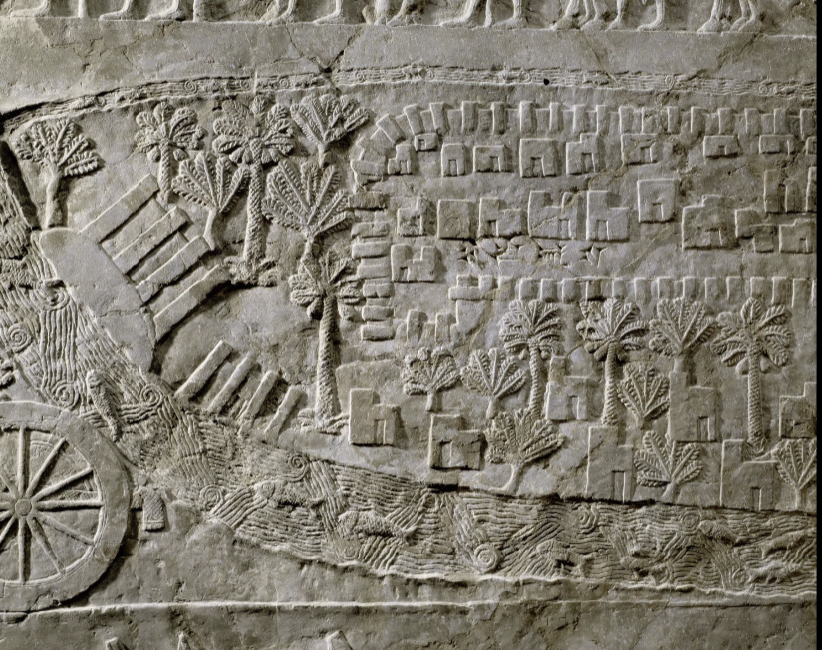
title, date, material, findspot
Battle of Til Tuba Panels (Elam)
Neo-Assyrian Period, 650 BC
Gypsum alabaster
North Palace, Nineveh, Iraq
Battle of Til Tuba Panels (Elam)
Battle scenes
Shows a town (Elam town)
Town itself is abandoned → people have gone out to submit to the Assyrians
Procession of people being led → on way out
Women and children leaving
Below procession, there is a river
Bodies and wheels in river
Carcesses of men, horses
Cuneiform right in the town → tells what town it is about
Citadel
Can see town wall
Date palm growth
Not center, but suburban of town
Elevation point of view and bird's eye view
Depiction of enemies
Hunched, contorted, twisted
Assyrians are standing straight up → larger and ready to fight
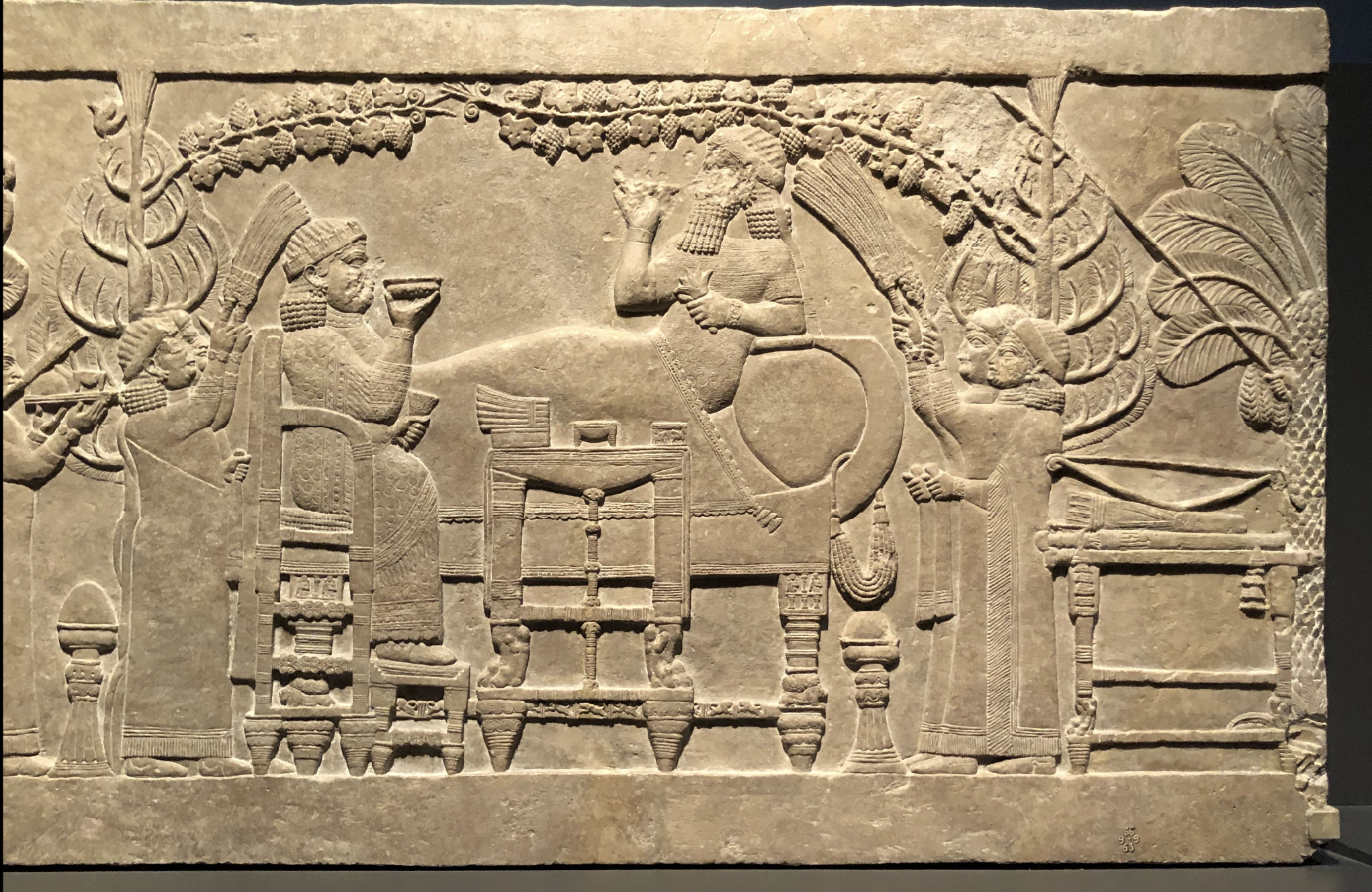
title, date, material, findspot
Ashurbanipal and Queen Taking Refreshment
Neo-Assyrian Period, 645 BC
Gypsum alabaster
North Palace, Nineveh, Iraq
Assurbanipal and Queen Taking Refreshment
One panel that is a summary of entire campaign in scene
King and queen celebrating their victory
Seated in an area that is covered in vines
King is reclining on couch
Detail on furniture! → high end Assyrian furniture
Holding flower, drinking
Queen is in a high back throne
Musicians behind king and queen
Surround king and queen
HARP!
Attendants are all female
Celebration could have taken place in the women’s corridor
Jewelry → Egyptianizing necklace
Egyptian collar/necklace
Refers directly to Assurbanipal’s campaign
Incredibly detailed
Table behind Assurbanipal is stacked with weapons
Eye, hair, and ear hanging from a tree in the garden → head of the Elamite king
Assurbanipal conquered
Jolting message → grim war scenes
MILITARY MIGHT
Botanical garden with all types of trees, fruits, and vegetables
GARDEN
Creates ideal setting
King’s power over conquered territory
Ability to create harmony
Neo-Babylonian Empire
626-539 BC
Achaemenid Persian Period
559-331 BC
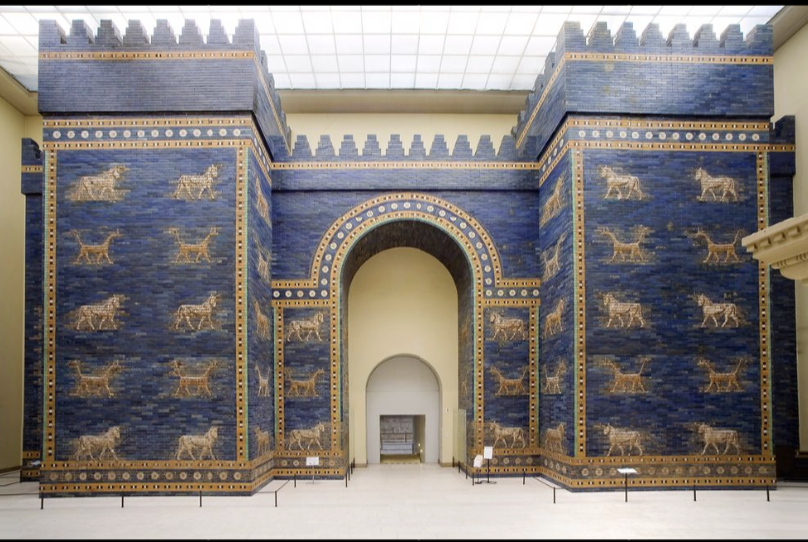
title, date, material, findspot
Ishtar Gate
Neo-Babylonian Period, 605-562 BC
(reign of Nebuchadnezzar II)
Glazed terracotta bricks
Babylon, Iraq
Ishtar Gate
Reconstructed
Stood 50 feet high
New years festival
Took cult statues out of city
During festival, they were brought back into the city
Plotting animals – animals in a row
Many are mixed, mythological animals to turn away evil
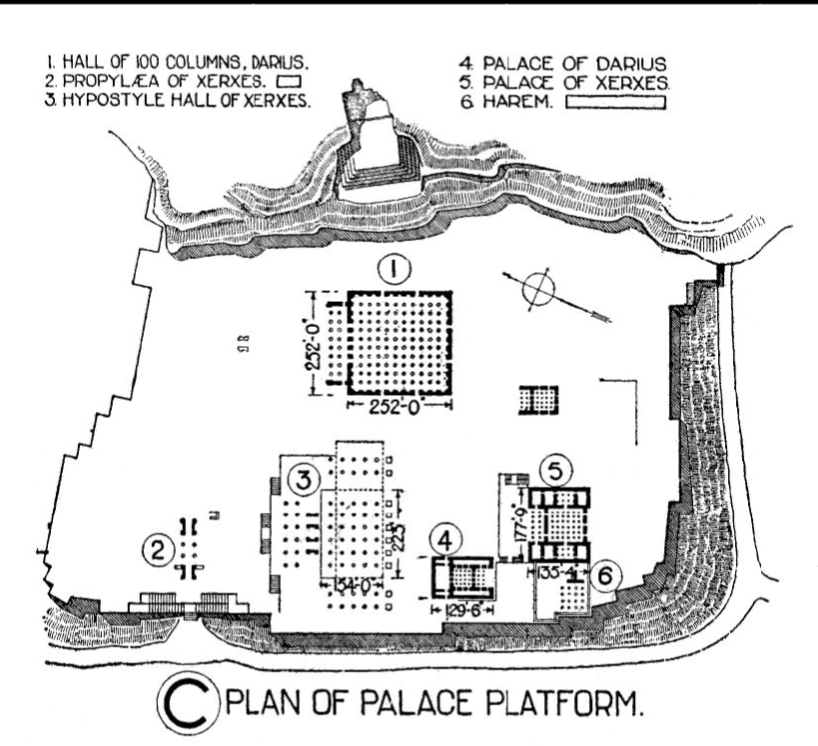
title, date, material, findspot
Palace at Persepolis
Achaemenid Persian Period (559-331 BC), c. 485-423 BC
Limestone
Persepolis, Iran
Palace at Persepolis
Palace was center
Massive complex
Gateway leads you right in to a massive hall
Was done by successors
Separate terrace
Stairways
About 250 square feet
Guard rooms
Three sides of it were surrounded by Corticos
Public area
Residential place for 1st ruler
Many private apartments
Famous area in southeastern part of palace – treasury
Surrounded by super thick walls
Recesses and buttresses
1000 of arrowheads were found
Many tablets were found – Persepolis tablets
Built on artificial terraces
Like temples on Ziggurats
Made out of mudbrick
Stone slabs (like Assyrian reliefs)
Baked glazed bricks
Gateways are protected by massive mixed mythological creatures
Square rooms form bases of plan
Nestled into mountains
Enclosed by a massive mudbrick wall
Only one entrance – northwest slide
Columns have distinctly Greek bases
Egyptian filtered through the Greeks
Threshold and gateway (seen in Assyrian palaces)
Gateway of all countries
Seeing other focuses on gateways
Gate Posts on Inanna (Uruk Vase, Anzu Relief)
Could be a potentially dangerous spot – in liminal space
Focus on gateway, threshold, and guardian figures
Typical form for a Persian gateway
Approached by long flights of step
Square and rectangle
Like Assyrian Palaces, this palace was a giant piece of propaganda
Center piece of Persian Empire
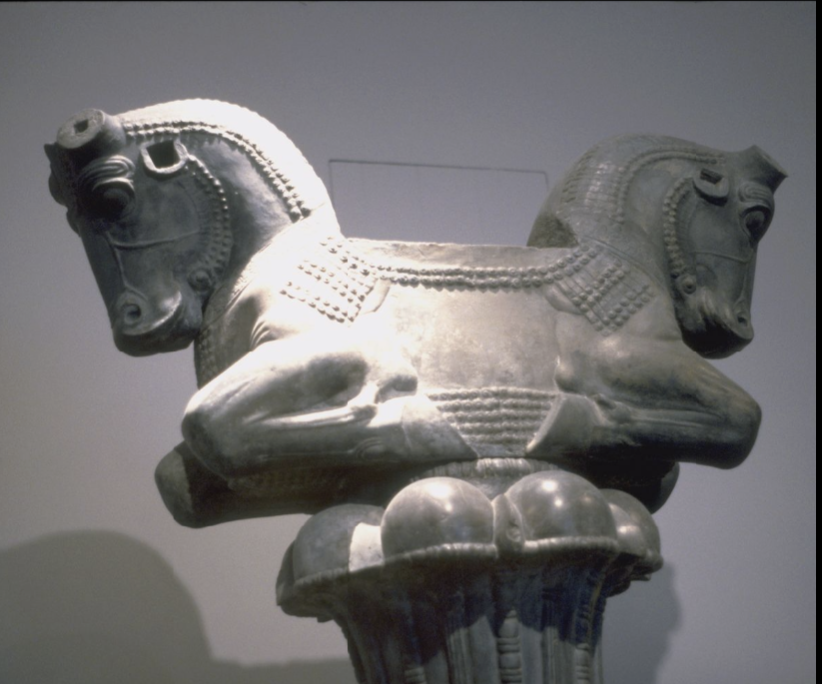
title, date, material, findspot
Achaemenid Columns
(Palace at Persepolis)
Achaemenid Persian Period (559-331 BC), c. 485-423 BC
Limestone
Persepolis, Iran
Achaemenid Columns
Gatehouse
Held with 4 columns
Made of stones
Clearly influenced by the Greeks
Derived from Greece (Ionia)
Rounded base shape – Ionian
Unique features – shape of capitals
Mix of Greek architectural style and Persian architectural style
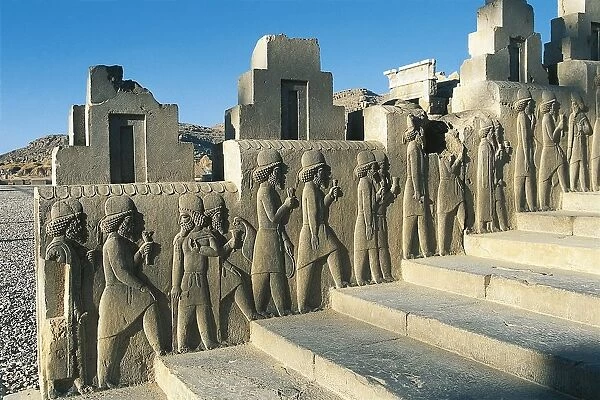
title, date, material, findspot
Dignitaries Climbing Stairway of Tripylon
(Palace at Persepolis)
Achaemenid Persian Period (559-331 BC), c. 485-423 BC
Limestone
Persepolis, Iran
Dignitaries Climbing Stairway of Tripylon
Flanking stairways
Take you up along the sides of the platform
Stairway Leading to Audience Hall
Leading into a massive reception room
All manner of reliefs in various sizes that were decorating entry ways throughout the palace
Subjects/Depictions:
combat scene
Motif of lion → in action
Protoliterate period → lion attacking stag
Theme of combat
Armies in profile (protoliterate period)
Soldiers
Includes guardsmen
Headdresses relate to weapons (rectangular or circular headdress goes along with weapons)
Visitors processing
Internal visitors walking up stairs
Tribute bearers
Carved to be processing up the steps → giving gifts to kings (different items)
Submissive to king
Tribute the king
Power is reaching far
Shows that king cares
Power of the King (lion and the king)
New Persian style
Very distinct hairstyle
Round curls
Muscular → smooth and relaxed
More rounded, not a focus on detail of anatomy
New kinds of garments of iconography
New costumes
Figures are a bit more 3-dimensional (not a high relief – slightly higher relief compared to other periods)
Details:
Comes more forward (see in bottom of clothes – folds of clothing)
Stone with subtraction
Modeling!!
modeling/shaping a surface to show details
Difference in relief
Variety of levels
Beard shapes to face (where jaw meets neck)
See eyebrow ridge